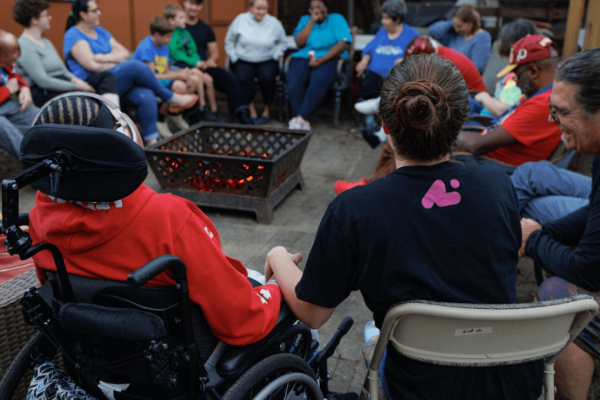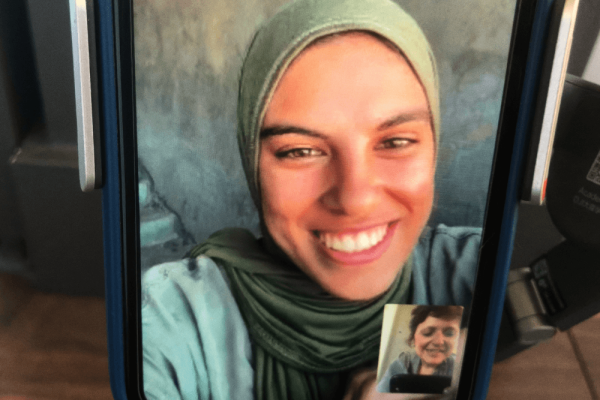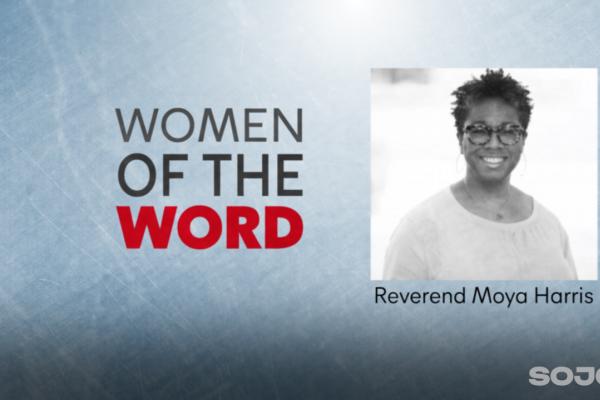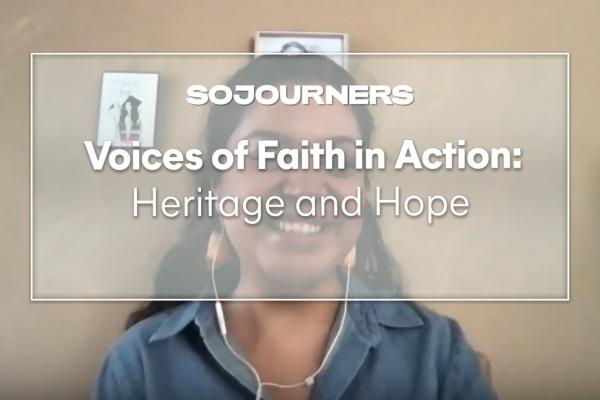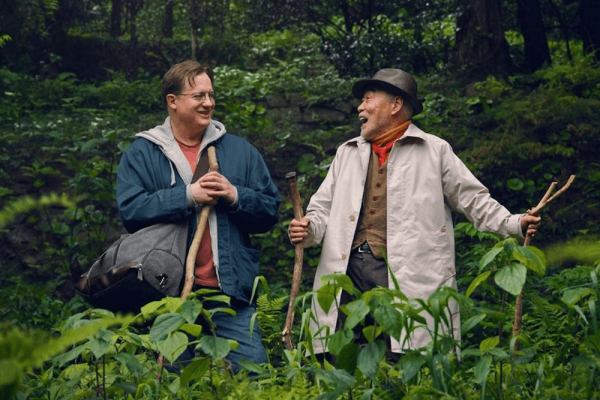On Maundy Thursday, in a hospice room on the fifth floor of Washington, D.C.’s Sibley Memorial Hospital, Michael Leo Schaff rested on an inclined bed and leaned his head on the left side of his pillow. His eyes still retained some of their shimmer and mischief. Though he was no longer able to eat or speak, he listened as his friend and former housemate Laura shared some family gossip that she knew Michael would appreciate. Now and then, Michael raised his eyebrows or widened his eyes.
Michael is the founding core member of L’Arche Greater Washington, D.C., a community of adults with disabilities and without disabilities. The core members are adults with intellectual and developmental disabilities (IDD) at the heart of our community life, and assistants provide daily support to the core members. I was welcomed as an assistant by Michael and others in 2014, when Michael dubbed me “Giggles.” He was one of many people who had been living the rigor and beauty of community life for decades, but none for longer than him. In Michael’s 42 years with L’Arche, he welcomed hundreds of assistants like Laura to live and work in his home.
Laura is just one of dozens who visited Michael in the hospital, called him on his iPad, or flew across the country to say goodbye. His friends shared small sensory details that Mike would appreciate — purple nail paint, a book about President Abraham Lincoln, the obituary section of the Washington Post. Some knelt by his bed. Others kissed his forehead. One assistant volunteered to sleep in the hospital room overnight and keep Mike company. Overwhelmed by the sheer number of visitors, the hospice nurses asked our community leaders: Who is this guy?
While all kinds of people carve out time in their week to see Michael in his last days, the inverse is true for the majority of adults with intellectual disabilities. In an era of isolation, the barriers to community for adults with IDD are legion. According to Covey, a nonprofit creating opportunities for individuals with disabilities and their families, adults in the general populace have 125 people in their social networks, whereas adults with intellectual disabilities have 3.1 people in their social networks who are not paid to be with them. Many adults with disabilities live their days in profound isolation. But during Holy Week this year, a group of assistants, friends, and strangers gathered in an upper room around Michael.
The second half of the 20th century was marked by tremendous suffering for many American adults with disabilities. In the D.C. area, an institution called Forest Haven was perhaps the Golgotha and epicenter of this pain. Here, adults with intellectual disabilities were hidden away, with many families receiving encouragement from doctors to send their children to Forest Haven. Sometimes one caregiver would be responsible for 40 individuals with significant needs. It was commonplace for residents of Forest Haven to be bathed alongside others outside, naked, standing in a line, while someone hosed them down. Some were forced to sleep in beds with caged coverings against their will. It was, as one of our core members put it, “a jailhouse.”
When Forest Haven was shut down by a judge for severe neglect in 1991, many in the D.C. area believed that adults with intellectual disabilities would experience a qualitative improvement in their daily lives. But their illusions were punctured when Katherine Boo wrote a series of essays in the Washington Post in 1999, chronicling the stories of adults with intellectual disabilities who moved into group homes. The first of her series focused on a young man who was repeatedly raped for a year before any action was taken. Boo named her series Invisible Lives: Forest Haven is Gone, But the Agony Remains.
In 2007, U.S. District Court Judge Ellen Huvelle described D.C.’s failure to adequately comply with the lawsuit that closed Forest Haven as “systemic, continuous, and serious noncompliance.” In 2016, Huvelle concluded the lawsuit after some improvements, acknowledging how much work was left to be done. So, what’s next? What comes after compliance? In some settings, so much focus is now given to compliance that perhaps we are missing more fundamental questions about belonging, friendship, and loneliness. Right now, in the midst of our loneliness epidemic, adults with disabilities are among the most likely to be completely isolated from meaningful friendships. One in four people with disabilities say they have zero close friends.
So, how can the physical space of a home give primacy to relationships? How can we make group homes feel like homes? As the Outreach Coordinator for L’Arche Greater Washington D.C., and as a friend to a handful of adults with intellectual disabilities who live in other group homes, I am often struck by the attention that people pour into homemaking — the paintings and pictures on the wall, the tablecloths and funny sticky notes, the greenery, the disparate collection of mugs, all the evidence of pranks and life and love. Or in some contexts, the absence of these elements, creating something more barren and sterile.
A couple of years ago, I was struck by an interaction that one of our core members, Bruce, had with a dinner guest. After exchanging pleasantries, Bruce pointed to the clock that he had recently purchased at the store. Bruce said, “That old clock no good … this one is better; this one is strong.” Bruce’s pride in his own home — and in his own contributions to making it a home — caught me off guard.
It dawned on me then how rare an experience this is. How many adults living in group homes have guests over for dinner? How many adults with intellectual disabilities get to take the lead on purchasing something as mundane as a clock in their home? How many get to decorate their homes and have guests over who want to enjoy that setting with them?
L’Arche challenges the notion that a group home is predominantly a place to provide care services. We have learned over time that the health of our community is rooted in how we gather, celebrate, and make known the unique gifts of every person. This does not diminish the work of competent caregiving, but rather, it places it in a larger context that recognizes how ritual and gathering emphasize a person’s gifts and beauty rather than their diagnoses.
Whether it is our yearly house vacations, our weekly birthday and anniversary celebrations, or our daily practice of sharing dinner and prayer-by-candle each evening, we have rituals that help us pause. We have ways of being that remind all of us — those with intellectual disabilities and those without disabilities — that we belong together as a family. These rituals hold us together.
In his book, Ritual: Healing, Power and Community, Malidoma Somé calls ritual the anti-machine. In a society that deems some people as a burden and disruption to society’s machinery, L’Arche has experimented with rituals for decades, by necessity, as a way to tether ourselves to each person’s dignity and humanity and depth.
One of our late, beloved core members named Andrew taught us this. He was non-verbal and spoke with signs and gestures. Each Tuesday, when our community would gather for a birthday, anniversary, or farewell, Andrew would rock back and forth when he would hear the first words of our liturgy: Here in the buzz of city life, we pause to celebrate three events. The liturgy called forth a different gaze and different posture from Andrew.
Francis Weller writes that in ritual space, “movement, rhythm, expression of emotion, and direction of attention all open gateways to the sacred.” Sadly, outside of L’Arche, I have never encountered a ritual in another group home. Government agencies provide important oversight to prevent neglect and medical incompetence, but I have yet to experience an audit from an agency that investigated the quality of our rituals. Who will provide the training, people, and resources to group homes to create the gatherings that retain our connection to the sacred? Who will do this humbly, following the lead of adults with intellectual disabilities in each home?
A culture of encounter
After many bureaucratic hurdles that kept him at the hospital longer than anticipated, the DC Department on Disability Services allowed Michael to return home for his final days. Michael died peacefully in his bedroom, next to two people who loved him, holding each of his hands. As is our custom when someone dies, the next evening we gathered together as a community. About 40 people squeezed into his living room to “say good things about him,” as he asked for in his final wishes. Children and long-time friends, current assistants and past assistants, leaders and members of other L’Arche homes all joined shoulder-to-shoulder to sing the songs that Michael loved and to share stories about him: daily adventures to McDonald’s for a decaf coffee, his recent monochromatic clothing style, trips taken to presidential libraries and cemeteries, debating with Michael about politics, the delightful way he’d cover his mouth with his hand when he was up to something mischievous.
In the first year of L’Arche, some core members who came from Forest Haven were so accustomed to unsafe settings that they chose, night after night, to have supper in their own room. At first, it was only Michael who would show up at the dining table. But with time, because of Michael’s steadiness, the Ontario House dinner table became a place where others felt welcome to come and share a meal. Since then, this ritual of shared meals and after-dinner prayer among assistants and core members has become a crucial practice for all of us.
Through such rituals, we cultivate what Pope Francis called “a culture of encounter.” Through the hard-earned wisdom of forebears like Michael in our community, we have inherited ways of being together that help us create a more human and less lonely world.
You can watch L’Arche Greater Washington, DC’s short film On Loneliness here.
Got something to say about what you're reading? We value your feedback!
